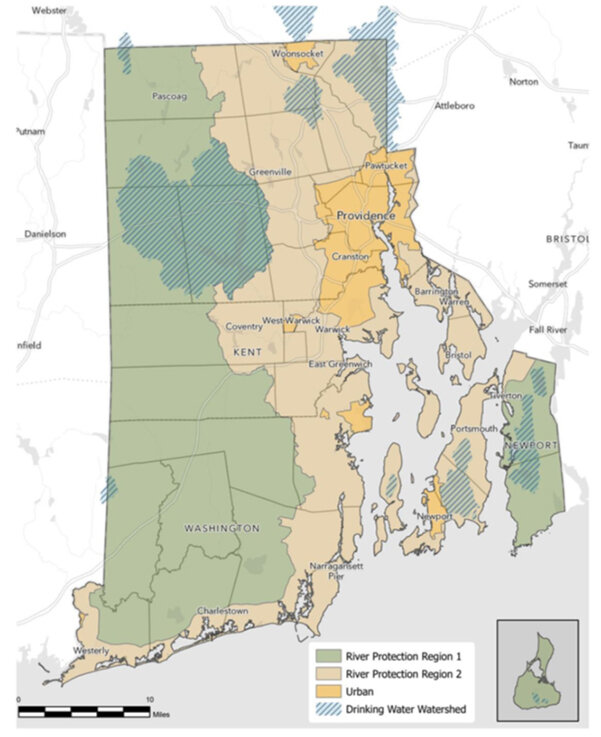New Freshwater Wetlands Rules Create Uniform Buffers
DEM and CRMC enforced regulations set to go into effect early next year
October 11, 2021
Stakeholders still have mixed reactions to new rules regarding Rhode Island’s freshwater wetlands. This summer the Rhode Island Department of Environmental Management (DEM) and the Coastal Resources Management Council (CRMC) filed rules mandating new protections for freshwater wetlands, in particular buffer zones — areas untouched by development — be kept a certain size adjacent to wetlands. The new regulations are scheduled to go into effect Jan. 15.
The new rules create different jurisdictional areas to be regulated by DEM and CRMC. They replace local ordinances in favor of statewide standards, a longstanding request by developers. In most cases, buffer areas will extend 200 feet from the edge of a river, floodplain or reservoir, and 100 feet for most other freshwater wetlands. DEM estimates 23,900 acres will fall under these new regulations.
Freshwater wetlands in Rhode Island include marshes, swamps, bogs, ponds, lakes, rivers, streams, vernal pools, and certain adjacent areas including floodplains. Any in the vicinity of the coast fall under CRMC jurisdiction, and all others are regulated by DEM. Wetlands reduce flood and storm damage, maintain stream flow during drought, protect and improve groundwater quality, provide habitat for fish and other wildlife.
Critics say that areas that will now have lower buffer limits — because some municipal regulations required more protection — will endanger important environmental benefits wetlands provide.
Save The Bay riverkeeper Kate McPherson doesn’t support the new statewide buffer zones.
“Urban wetlands and urban rivers pay the price for some gains in buffer protection elsewhere in the state, and Save The Bay is really disappointed in this outcome,” she said.
McPherson noted her concern is the buffers as they are to be enacted are too small and will further impact water quality and habitats. Water quality can be impacted if a residential development uses fertilizer, or if an invasive species escapes from a backyard.
“Wetlands are an important wildlife habitat, food source, shade rivers and streams, and help protect fish habitats,” she said.

Most municipalities will see an increase in buffer protection areas. A few, such as Jamestown and Little Compton, will see a decrease in their current buffer zones, from 150 feet to just 50. Municipalities can petition DEM for an increase in buffer areas, but are losing veto power originally granted to them in a previous version of the proposed rules.
Any development in these newly defined buffer areas will require a special permit, unless otherwise exempt. DEM has made additions to possible exemptions.
New exempt activities to freshwater wetlands rules now include cutting vegetation within lawns or landscape areas, forest management practices, cutting within floodplains outside wetlands and jurisdictional areas, maintenance of parking lots, additions of gates or barriers at existing and approved driveways and access roads, installation of signage, restoring wetlands from unauthorized disturbances associated with enforcement action, and establishing new pedestrian trails outside of wetlands and their buffer zones.
These exemptions, according to DEM, are “limited activities that do not present impacts to freshwater wetlands that merit review.” The rules also establish a process for a general permit, for routine projects with predictable and limited impacts.
Not all environmental organizations have been critical of the new rules. Save The Lakes, an organization dedicated to the preservation and protection of Rhode Island’s freshwater resources, believes DEM handled public comment reasonably well. In an email to ecoRI News, Save The Lakes director Ron Entringer wrote, “I think the final rule meets our expressed comments.”
Some in the business community, however, are displeased with the new buffer regulations, claiming they will impair the ability to build affordable housing. The Rhode Island Builders Association submitted 72 pages of testimony to DEM in January laying out its concerns. The association said the new rules would impact development in the western part of the state and would hinder homeowners from doing projects on their own property. It claimed DEM’s cost-benefit analysis was fundamentally unsound. The buffer sizes are also much bigger than other states in New England, according to the Rhode Island Builders Association.
Rhode Island Association of REALTORS president Philip Tedesco said of the new regulations, “We are satisfied that the new rules for wetland buffers are a step in the right direction ecologically without being overly onerous in terms of increased zoning regulations that raise the cost of housing.”
Efforts to create statewide wetlands protection standards began in 2013 with a 16-member legislative task force. Based on its recommendations, the General Assembly passed a legislative mandate in 2015 that called on DEM and CRMC to establish freshwater wetlands protections and enforce them. The process was delayed because of disagreements between environmental and business interests, DEM staff retirements, the coronavirus pandemic, and a state mandate to digitize all rules online.
“We believe the proposed regulations provide a balance between the benefits of environmental protection, the economic interests of land development, and the need for more affordable housing in our state,” said acting DEM director Terrance Gray. “The regulations provide certainty and consistency on the standards for wetlands permitting across the state and more options for quicker, streamlined permitting for development and affordable housing projects, while ensuring better buffers for important wetlands areas to protect their functions and values.”




The great unanswered question remains: Will the General Assembly fund the DEM positions needed to implement this new wetlands regime, or will the presently controlling real estate development interest continue to keep DEM on a starvation budget?
In the "public comment" & DEM response on the new rules, (link above,) we find this revealing exchange between URI wildlife scientist, Nancy Karraker, and DEM:
"Rare Species Protection
Comment 113: Dr. N. Karraker asked how DEM will know if rare animals or plants occupy a site given there is no RI endangered species law and the Natural heritage database is outdated. Who will conduct surveys to document their presence?
"Response 113: The DEM anticipates a similar level of effort on the part of applicants and the Wetlands Program as presently conducted to assess the presence of rare animals, rare plants or rare wetland types within the authority of the wetlands statute and these Rules. We will continue to rely upon existing RI-specific references as described within Rule 2.3(A) and (B) and supporting databases."
How many RI residents concerned about wildlife realize that there is no RI endangered species protection? (This dirty secret deserves major media attention.) And how many realize that the one program DEM once had for monitoring our state endangered species and their habitats, the Natural Heritage Program, has been conveniently penciled out of DEM’s budget since 2007?
DEM’s mealy-mouthed non-response to Dr. Karraker’s question shows how dispirited and groveling the institution has become under this fiscal assault of now two-decades long duration.
We’ve done a pretty good job saving the bay and saving a lot of whales, etc., but we don’t extend meaningful protection to terrestrial endangered species in our State.
"Why?"
why doesn’t it surprise me that the RI Builders association is complaining about the new regulations. all dave caldwell and his predecessors have ever done is complain about regulations of which the differing individual town regulations must have driven him nuts. they are a bit to keep up with. the complaint that new wetlands regulations will negatively impact the construction of affordable housing is nonsense. affordable housing which has to be part of every subdivision is constructed on land which has been determined to be buildable within the subdivision. it doesn’t occur on land which would otherwise have been unbuildable for conventional development due to the fact that it is within the wetlands regulatory purview. and as a matter of fact the new regulations unify the wetlands buffer requirements where previously DEM would have a 50′ setback and towns would have a 150′ setback requiring the applicant to deal with the locality in asking for relief. now that has gone away. regulations are born of bad behavior. the plethora of wetlands regulations probably wouldn’t be as onerous if developers didn’t historically attempt to maximize the living units per square foot regardless of the presence of wetlands along with other physical conditions like high ground water, lack of reinforcement in concrete foundations, the use of OSB anywhere on a building, windows that are constructed with finger jointed pine sills which delaminate over time, finger jointed pine trim which turns to garbage long after the builder has left the building, poorly compacted cellar and garage subgrades which cause numerous cracks and settlement in concrete slabs, burying stumps which 20 years later create sink holes that the homeowner has to correct and filling lots without properly compacting the lifts of soils resulting in foundation settlements and expensive remedial efforts years down the line. i could go on but i don t have time. i can hear the smallest violin playing for their terrible plight.
Right you are, Bill. But, how mealy-mouthed is the DEM response? Consider their statement: "The DEM anticipates a similar level of effort on the part of applicants and the Wetlands Program as presently conducted to assess the presence of rare animals, rare plants or rare wetland types…"
The "applicants" are assumed to be the developers, but the actual assessment is conducted by environmental consultants hired by the developer to prepare the applications for wetland alterations. It should not be difficult to understand that some consultants will do everything they can to insure their client gets the permit.
Once upon a time, in the years between 1979-2007, there was a Natural Heritage Program at DEM that reviewed development projects for potential impacts to rare and endangered species and ecosystems. During the tenure of the program, literally thousands of projects were reviewed, mostly at the request of and consultation with the environmental consultants. When the NHP was dissolved in 2007, the review of projects for rare species was left entirely in the hands of the consultants who had access to, on the public DEM website, a map showing the known occurrences of rare species, the so-called Natural Heritage coverage.
With no obligation to do otherwise, consultants now submit wetlands applications with their assessment of rare species limited to a 10-second map check. To be frank, some consultants have purposely misinterpreted the mapped data to their clients advantage.
When you ask "Why?", let’s consider who the clients are. Misinterpretation of the data was clearly done for two high profile projects – the Clear River Energy Center and the Tiverton Casino. In both cases, the environmental consultants (both RI-based) provided limited and incomplete assessments. The original site-selection study for the CREC, for example, claimed there were no rare species at the preferred Burrillville location where later more than 15 were found.
These two projects, and others, received major state backing and would have been somewhat problematic for DEM to "over-regulate". Terry Gray provided the DEM advisory opinion on the CREC saying basically that as long as the regulations were followed there would be no adverse environmental impact. No room for interpretation.
Wetland buffers are another example of cookie-cutter regulations that assigns a common value to all buffers without consideration of what is living in the wetland being buffered. Nancy Karraker is right being worried because many of the species she studies occupy wetlands only part of the year, spending much of their time in and beyond the regulated terrestrial buffer.
Two thoughts on setbacks and local jurisdiction. Shouldn’t the setbacks be measured from the edge of the wetlands as measured the wettest season/ day of the year? And maybe a town should be able make their own regulations as long as they are more conservative that the states?